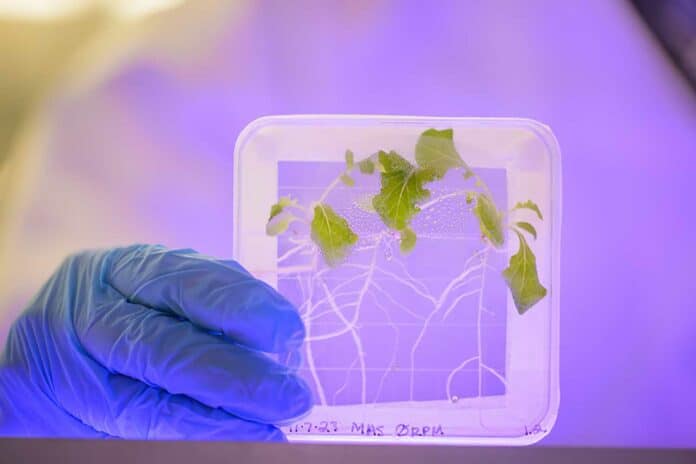When people spend a long time in space, growing crops is essential to keep them healthy. This is because being in space for a while can affect the way our bodies work, and growing plants can help counteract these effects. Also, leafy green vegetables in space can carry harmful bacteria that can make astronauts sick, so finding ways to grow food safely in space is crucial.
In a recent study published in Scientific Reports and npj Microgravity, scientists from the University of Delaware grew lettuce in conditions that mimic the weightlessness experienced aboard the International Space Station. Plants rely on gravity to guide their growth, using roots to detect it.
However, when the researchers exposed the plants to simulated microgravity through rotation, they discovered that these plants were more susceptible to infections from Salmonella. These bacteria can cause illness in humans.
Noah Totsline, a University of Delaware‘s Department of Plant and Soil Sciences graduate, explained that stomata are small pores in leaves and stems that plants use for breathing. Under normal conditions, these pores close to protect the plant when it detects a threat, such as nearby bacteria. However, in the study, when bacteria were introduced to lettuce in the simulated microgravity environment, the leafy greens responded unexpectedly. Instead of closing the stomata as a defense mechanism, the plants opened them wide.
“The fact that they were remaining open when we were presenting them with what would appear to be a stress was unexpected.”
The research team used a clinostat device to rotate plants at the speed of a rotisserie chicken on a spinner.
Totsline said, “The plant would not know which way was up or down. We were kind of confusing their response to gravity.”
“It wasn’t true microgravity, but it did the job to help plants lose their sense of directionality. Ultimately, the researchers discovered that Salmonella can invade leaf tissue more easily under simulated microgravity conditions than it can under typical conditions on Earth.”
Furthermore, researchers at the University of Delaware, including Bais, have previously demonstrated the beneficial effects of using a supportive bacterium called B. subtilis UD1022 to enhance plant growth and resilience against various challenges like pathogens and drought.
In their experiments, the researchers introduced UD1022 to the microgravity simulation, hoping it would offer protection against Salmonella, as it does on Earth. Surprisingly, the bacterium did not succeed in safeguarding plants under space-like conditions.
The lack of protection may be linked to the bacterium’s inability to trigger a biochemical response that would normally prompt a plant to close its stomata, the tiny pores that usually serve as a plant defense mechanism.
Plant biology professor Harsh Bais said, “The failure of UD1022 to close stomata under simulated microgravity is surprising and interesting and opens another can of worms. I suspect the ability of UD1022 to negate the stomata closure under microgravity simulation may overwhelm the plant and make the plant and UD1022 unable to communicate with each other, helping Salmonella invade a plant.”
Solutions: sterilized seeds and improved genetics
So, if plants are opening their stomata wider in a microgravity environment and allowing bacteria to easily get in, what can be done?
UD microbial food safety professor Kali Kniel said, “Starting with sterilized seeds is a way to reduce risks of having microbes on plants. But then microbes may be in the space environment and can get onto plants that way.”
“Scientists may need to tweak plants’ genetics to prevent them from opening their stomata wider in space.”
Journal Reference:
- Totsline, N., Kniel, K.E., Sabagyanam, C. et al. Simulated microgravity facilitates stomatal ingression by Salmonella in lettuce and suppresses a biocontrol agent. Sci Rep 14, 898 (2024). DOI: 10.1038/s41598-024-51573-y
